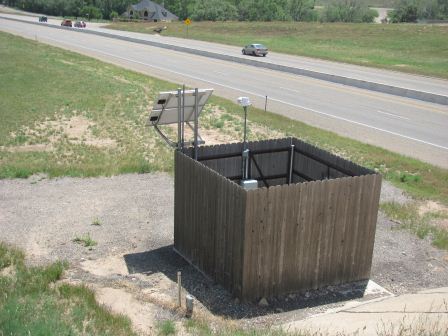Section 3: De-Icing & Anti-Icing Systems
Anchor: #i1001139Definitions
There are two distinct snow and ice control strategies that have been gaining popularity and show promise in making use of chemical freezing-point depressants: de-icing and anti-icing. Anti-icing operations are conducted to prevent the formation or development of bonded snow and ice for easy removal, while de-icing operations are performed to break the bond of snow and ice and eliminate the buildup on the roads. See Chapter 2, “Materials,” for information on the various chemicals available to use in these operations.
Figure 9-4. One means of achieving anti-icing is this automatic injection system in use in the Amarillo District. Photo shows chemical tank and controls, while the plumbing that gets the liquid to the road is underground.
Anchor: #i1001153Anti-icing
Anti-icing involves pre-treating a road before the freezing weather or storm arrives with the goal of limiting or preventing the buildup of ice. Successful anti-icing efforts require accurate timing and good judgment about when and where to treat, relying on weather forecasts, field sensors, and in-field measurements or observations to predict when a storm will hit and its severity.
Anchor: #i1001165Benefits
Studies by various agencies and institutions have identified several benefits of a sound anti-icing strategy:
- Anchor: #EGWBGTCO
- by preventing snow or ice from bonding to pavement, removal and control is much easier Anchor: #SPUAXAKE
- material is applied ahead of the storm, making it safer for equipment and operators Anchor: #RSSQERMH
- lower material application rates compared to de-icing operations Anchor: #TMEBBPEX
- the need for sand or other abrasives is reduced Anchor: #WPAIITRG
- cleanup of sand or other abrasives is reduced Anchor: #MKCORGIY
- reduced environmental impact.
Use with RWIS
Anti-icing can be more effective when coupled with a Roadway Weather Information System (RWIS). An RWIS helps to make informed decisions about when and where to deploy materials, crews and equipment.
While an anti-icing strategy coupled with an RWIS can be beneficial, there are some drawbacks associated with RWIS:
- Anchor: #WPLPNSLA
- high initial cost Anchor: #OQYBUUMS
- potential for premature and/or unnecessary application of materials Anchor: #UVGINFYB
- insufficient sensors/stations and the incompatibility of RWIS platforms Anchor: #ELIFEVVS
- overapplication of chloride-based chemicals can result in slick pavement Anchor: #FHWFWRGK
- high maintenance and upkeep costs.
Types of Application Systems
Anti-icing systems can be either mobile truck-mounted spray rigs, capable of covering large areas where needed, or fixed spray systems that will treat specific problem locations. Both use a chemical that can lower the freeze point of water, requiring a storage tank for the chemical. Generally, a 6,000-gallon capacity tank with agitation and circulation capabilities is used. However other sizes are acceptable, depending on specific local needs and conditions.
Anchor: #i1001255Mobile Application Systems
The equipment for a mobile system consists of a truck-mounted tank with a spray boom and controls for accurate calibration. Cost-effective dual herbicide/anti-icing spray units have been designed and built. In such dual-use systems, it should be noted that the chemicals used for anti-icing can be corrosive and thorough cleaning between seasons is necessary.
Commercial vendors can supply a large variety of types and size rigs suitable to the section’s needs. FOD purchases major equipment for all snow and ice control methods.
Anchor: #i1001270Fixed Application Systems
There have been marked advancements in the use of fixed anti-icing systems in the past few years. Fixed systems have been placed at toll plazas, super-elevated bridges and steep hills where maintaining vehicle traction is critical.
These systems use the same chemicals available for mobile anti-icing systems. They are designed and installed at problem locations and can be linked with RWIS to assist in predicting conditions favorable for treatment. Depending on the complexity of the RWIS equipment, the system can be activated remotely or automatically.
The spray systems themselves vary in complexity, but will spray the anti-icing chemical from fixed points onto the road’s surface. Traffic, in turn, will spread and track the chemical over the designed area providing the desired effect.
Fixed systems can be installed during new road construction or added at existing problem locations. Vendors specializing in fixed anti-icing systems can be found on the Internet.
Anchor: #i1001295De-icing
De-icing methods generally involve the use of chemicals to speed the melting process after snow pack or ice has formed on a road. Liquid chemicals with similar spray equipment can be used for de-icing, provided they can be applied at sufficient pressure to cut though the ice or snow pack. Caution must be exercised during de-icing since spraying liquids on top of the pack may cause the road to become slick. The use of dry solid chemicals and pre-wetted abrasives in conjunction with de-icing will speed the melting of the snow and ice pack. This practice will improve the de-icing process and reduce the time it would take to melt naturally
